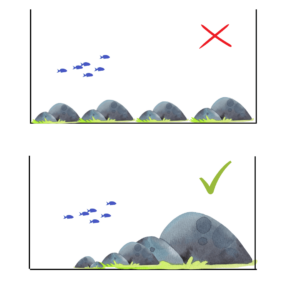Guide to Rocks for Aquascaping
Choosing hardscape, here’s our guide to rocks for aquascaping
Rocks and stones
Picking which hardscape to use can often feel bewildering. With such a huge range of rocks and woods available it can sometimes be difficult to know where to start. In this guide I will unwrap the different rocks available and shed some light on the best ways to use them, the ways in which they affect the water in your aquarium and why this is important, and how much to buy.
Some rocks are better suited to certain aquascaping styles than others.
Flowing rivers and streams.
In natural waterways we frequently see rocks. Fast flowing mountain streams will have a bed made up almost entirely of rocks and fine sand. Thousands of years of water moving over the land erodes away the earth revealing the bare rocks beneath. Over time these rocks are rounded off by the constant movement of water. If we are to accurately portray these kinds of environments in our aquariums we should choose stones with a smooth surface. Scottish Boulders, Scottish River Stones, Elderly Boulders, Black Venom and Wild Rhino Stone are all great example of naturally eroded Stones which will accurately match the environment of a flowing river or stream. For a hillstream aquascape don’t be afraid to use lots of rocks. Select an odd number of larger stones and place around them stones of varying sizes. Odd numbers will often appear more natural. Even numbers of rock all spaced at a uniform distance from one another across the tank has a very ‘Man-made’ feel and won’t look as effective as odd numbers.

Rocks of varying sizes placed off-centre give a much more natural effect.
Nature style
Nature style aquariums are often a representation of our own interpretation of nature. We aren’t trying to accurately mimic true environments, but rather display our own creative take on on what Mother Nature has provided us. This gives the aquascaper much more freedom to express themselves and bring the human concept of art in our living displays. Rock choice is therefore all in the hands of the aquascaper and their own vision. Rounded rocks like Scottish River Stones and Wild Rhino can be used to create a more natural scene, whilst rocks with more distinct and dramatic features such as Seiryu Stone, Frodo Stone, Geo Rock and Grey Mountain Stone can be used to make a bold statement. Whichever style you choose it is a good rule of thumb to pick one type of rock and stick with it. This will give you a more natural appearance and make the scape more cohesive and less muddled. Different Stones can be used for detailing but try to match colours and tones where possible.
Iwagumi
Iwagumi is a Japanese style of aquascape where the only hardscape used is rocks. They are often created using just 3 stones, large, medium and small. When done well Iwagumi aquascapes are incredibly beautiful and really do evoke a sense of calm and zen. With the rocks as the main focus, try to select the most beautiful and striking pieces. Stone suited best suited for Iwagumi layouts include Seiryu stone, frodo stone, Geo Rock, Grey Mountain stone, Dragon Stone and Dark Seiryu Stone. Smooth Stones with texture can also give a great affect, Wild Rhino Stone is stunning when used in Iwagumi style.
Paludarium
In this paludarium we used Frodo Stone
A display with both an aquarium and terrarium section is called a paludarium. Often with paludariums it is necessary to build up hardscape, perhaps gluing pieces together so they emerge out of the water, or to create waterfall features. A great choice for these setups is Black Lava Rock. Lava rock is usually relatively light weight and can be broken up easily with a hammer. Joins are easily hidden as the rock does not not have any directional detailing, providing seemless joins as if several pieces are one large stone. Black Lava also has the ability to absorb water which makes it the perfect growing platform for mosses. Black Lava is great value for money and is inert.
Rocks and livestock
The most important factor in your aquarium is the health and happiness of the livestock. We can provide both a beautiful and a healthy home for our fish, shrimps and snails as long as we take their needs into consideration when making our artistic choices. Some fish will prefer rounded rocks on which to graze, or they may have delicate fins which could become damaged on sharper edges. These species are best avoided if you plan on using rocks that could be harmful to them.
Water parameters.
Some rocks and stones will raise the hardness of the water. This can be detrimental to the health and longevity of certain species of fish and shrimp which have developed to thrive in softer waters. Rocks which can potentially raise the hardness of water include Seiryu Stone, Geo Rock, Grey Mountain Stone, Ocean Rock, Holey Stone. Regular, weekly water changes can keep most water hardening issues in control. Rocks which will not effect the the chemistry of the water are referred to as ‘Inert’. Examples include Wild Rhino Stone, Dragon Stone, Lava Rock, Blue Fin Stone, Jade Stone.
How much rock to use.
With so many varying styles to choose from it can be tricky to gauge how much Stone to order. Rock is nearly always sold by the kilo so not being at the shop in person to hand pick stones can be difficult. As a rough guide we recommend 5kg of rock for every 25L of aquarium volume. This will give you a good range of sizes to create a beautiful layout. On the product pages we have displayed an example of 2kg of each rock to help you guage quantities. If you require more specific shapes or sizes please do get in touch via our contact us form, email or phone, or visit us in store where we have a large sand ‘Dojo’ in which you can try out different layouts before you commit to buy.
Preparing your rocks
Most rocks arrive clean, however some dust, dirty or even old mosses may be present, remember these are natural materials (which is why we love them so much!). Give your hardscape a good rinse under the tap and dab dry. Dragon stone may require more intensive rinsing due to its clay-based make up. A high pressure hose is a good option to blast out the clay from the holes. Don’t worry if you don’t get it all, it will not harm your fish and any clouding of the water will be dealt with by the filter.



